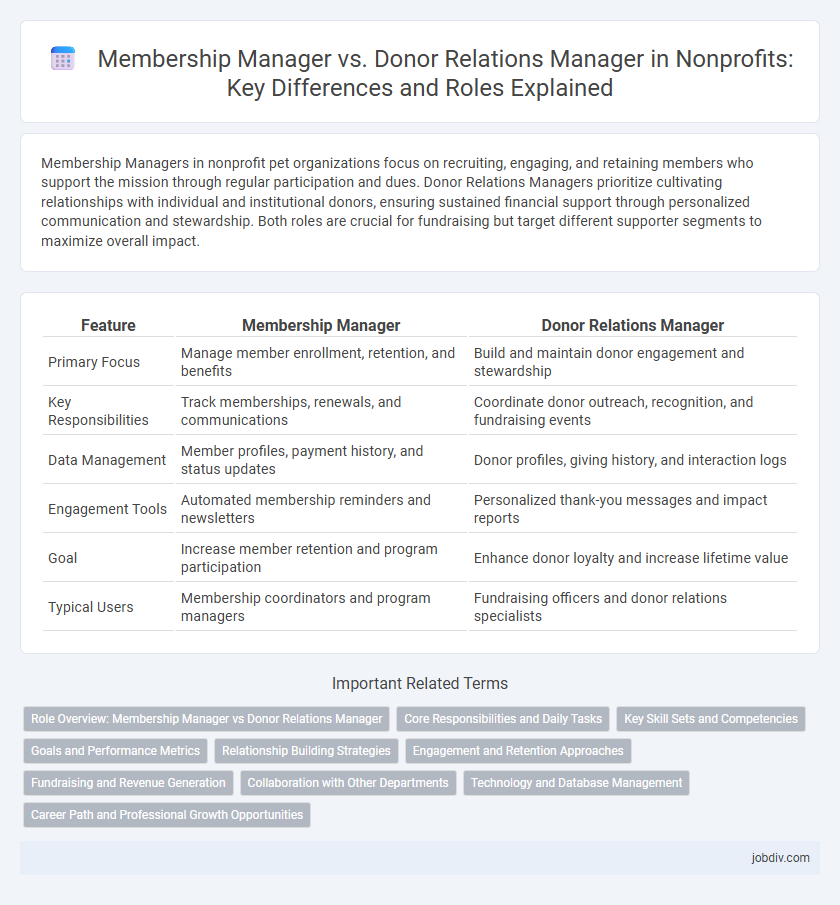Membership Managers in nonprofit pet organizations focus on recruiting, engaging, and retaining members who support the mission through regular participation and dues. Donor Relations Managers prioritize cultivating relationships with individual and institutional donors, ensuring sustained financial support through personalized communication and stewardship. Both roles are crucial for fundraising but target different supporter segments to maximize overall impact.
Table of Comparison
| Feature | Membership Manager | Donor Relations Manager |
|---|---|---|
| Primary Focus | Manage member enrollment, retention, and benefits | Build and maintain donor engagement and stewardship |
| Key Responsibilities | Track memberships, renewals, and communications | Coordinate donor outreach, recognition, and fundraising events |
| Data Management | Member profiles, payment history, and status updates | Donor profiles, giving history, and interaction logs |
| Engagement Tools | Automated membership reminders and newsletters | Personalized thank-you messages and impact reports |
| Goal | Increase member retention and program participation | Enhance donor loyalty and increase lifetime value |
| Typical Users | Membership coordinators and program managers | Fundraising officers and donor relations specialists |
Role Overview: Membership Manager vs Donor Relations Manager
Membership Managers oversee recruitment, engagement, and retention of organization members, ensuring growth and active participation in programs or events. Donor Relations Managers focus on cultivating relationships with individual and institutional donors, managing acknowledgments, and stewarding contributions to maximize fundraising outcomes. Both roles require strategic communication and data management but target distinct stakeholder groups to support nonprofit sustainability.
Core Responsibilities and Daily Tasks
Membership Managers focus on recruiting, engaging, and retaining members by managing membership databases, coordinating events, and developing communication strategies to enhance member loyalty. Donor Relations Managers concentrate on cultivating and maintaining relationships with donors through personalized outreach, recognition programs, and stewardship activities to maximize fundraising effectiveness. Both roles require data analysis and communication skills but differ in targeting ongoing member engagement versus targeted donor stewardship.
Key Skill Sets and Competencies
Membership Managers excel in community engagement, database management, and event coordination, focusing on member retention and growth. Donor Relations Managers specialize in personalized communication, fundraising strategies, and stewardship to cultivate long-term donor loyalty. Both roles require strong interpersonal skills and data analysis but differ in targeting members versus donors for organizational sustainability.
Goals and Performance Metrics
Membership Managers prioritize growing and retaining active members, focusing on metrics such as membership renewal rates, engagement levels, and event participation. Donor Relations Managers concentrate on cultivating donor loyalty and increasing donation amounts, tracking metrics like donor retention rates, average gift size, and upgrade rates. Both roles aim to strengthen organizational support but measure success through distinct engagement and fundraising outcomes.
Relationship Building Strategies
Membership Managers prioritize cultivating long-term engagement by creating value-driven communities, utilizing personalized communication and targeted outreach to retain members. Donor Relations Managers emphasize building trust through tailored stewardship plans, transparent reporting, and meaningful recognition to foster ongoing financial support. Both roles leverage data analytics and CRM tools to refine their relationship-building strategies, enhancing loyalty and commitment among stakeholders.
Engagement and Retention Approaches
Membership Managers prioritize personalized communication and exclusive benefits to enhance member engagement and improve long-term retention rates. Donor Relations Managers emphasize tailored stewardship, regular impact reporting, and meaningful recognition to sustain donor loyalty and increase repeat contributions. Both roles utilize data-driven strategies to analyze engagement patterns and optimize retention efforts within nonprofit organizations.
Fundraising and Revenue Generation
Membership Managers drive fundraising by expanding and engaging a nonprofit's membership base, leveraging subscription fees and member contributions as steady revenue streams. Donor Relations Managers concentrate on cultivating long-term relationships with individual and institutional donors, optimizing personalized communication to maximize major gifts and recurring donations. Both roles are essential for sustainable revenue generation, with Membership Managers focusing on broad support and Donor Relations Managers targeting high-value contributors.
Collaboration with Other Departments
A Membership Manager collaborates closely with marketing and events teams to design engagement campaigns that increase member retention and acquisition. The Donor Relations Manager works with development and communications departments to cultivate donor relationships and coordinate fundraising initiatives. Both roles require seamless interdepartmental communication to align membership growth and donor stewardship strategies effectively.
Technology and Database Management
Membership Managers prioritize technology systems that streamline member enrollment, engagement, and retention using CRM platforms like Neon or Wild Apricot, ensuring accurate database segmentation and automated communication workflows. Donor Relations Managers focus on advanced donor management software such as Bloomerang or DonorPerfect to track giving history, personalize stewardship, and optimize fundraising campaigns through data analytics. Both roles require proficiency in database management, but Membership Managers emphasize member lifecycle management while Donor Relations Managers concentrate on donor insights and relationship cultivation.
Career Path and Professional Growth Opportunities
Membership Managers typically advance by deepening expertise in community engagement and expanding leadership roles within member services, often progressing to senior management positions such as Director of Membership or Community Relations. Donor Relations Managers develop skills in fundraising strategy and donor stewardship, positioning themselves for advancement into roles like Development Director or Chief Fundraising Officer. Both career paths offer dynamic growth opportunities through specialization in relationship management, strategic planning, and organizational development within the nonprofit sector.
Membership Manager vs Donor Relations Manager Infographic

 jobdiv.com
jobdiv.com